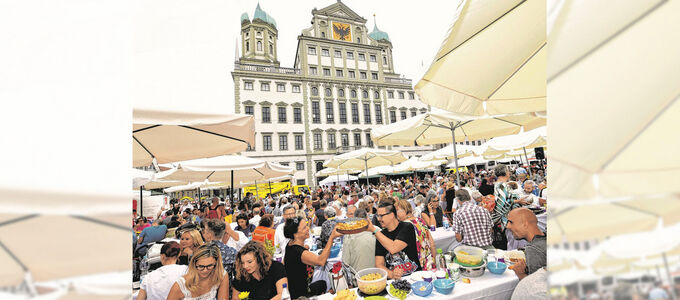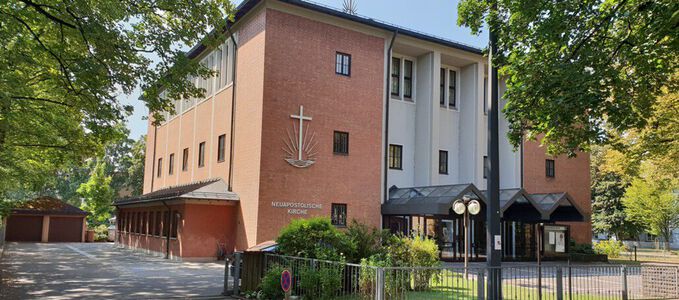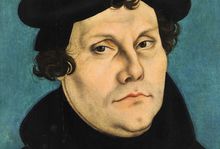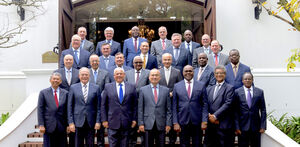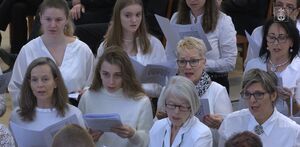Augsburg: The city where religious peace was established
In the sixteenth century, the dispute over Luther's theses brought the Reformer to Augsburg, Germany. First there was a loud argument, but then the parties arrived at an agreement that ensured peace between the denominations for years to come. And now Chief Apostle Jean-Luc Schneider is about to visit the city.
It seems faith has given the people of Augsburg an extra holiday: every year on 8 August, the city celebrates the Peace Festival. Instead of going to the office, many people come to the square in front of city hall on this day to share their food and celebrate with others at the Peace Table. It is a beautiful sight—and, although this tradition has only been celebrated for a few years, it has its origins in the sixteenth century.
It was in October 1518 that Martin Luther came to Augsburg. It had been a good year before that he had posted his 95 theses on the door of Wittenberg’s All Saints’ Church, thereby calling into question a number of prevailing religious opinions and practices, among them letters of indulgence. Luther unleashed an earthquake in the German Empire and in Rome. The Catholic Church accused him of heresy and began a trial against him. He was told he would die if he did not recant. At a hearing in Augsburg he was called upon to answer questions from the papal envoy Cardinal Thomas Cajetan—and to withdraw his theses. The duel of the theologians took place from 12-14 October 1518, and ended without agreement.
Luther in Augsburg: A loud argument with the papal envoy
Luther refused to recant, and when he simply left the room on the third day, Cajetan is said to have shouted after him: “I do not wish to talk to this beast any longer, because he has deep-set eyes and strange speculations in his head.” Luther then fled Augsburg with a little help from the mayor's son, who held open a gate in the city wall for him, guiding him with the words, “Down there!”
A few years later, in 1530, the “Augsburg Confession” was presented in Augsburg. This Confessio Augustana incorporates the essential principles of the “new” faith. Another 25 years later, the followers of this confessional text were finally put on an equal footing with those of the Roman Catholic Church when the Peace of Augsburg was concluded. This agreement enabled both denominations to live together peacefully—at least for a few years.
A record of this period of calm is still carved into stone in the cityscape today: centuries later, two double churches—a Protestant and a Catholic church building nestled close together—still provide architectural evidence of this peaceful coexistence of the denominations. A number of members of the wealthy Catholic Fugger family have their burial place in the Protestant Church of Santa Anna. Augsburg's largest New Apostolic Church congregation is located just over a kilometre from these special places in a residential area characterised by historic villas on the one hand and modern apartment blocks on the other.
Only two churches in Bavaria were allowed to hold public church services
In 2021 the New Apostolic Churches in the region celebrated a significant anniversary: it had been 125 years before that the New Apostolic Church in Bavaria, and thus also in Augsburg, had been established. Two men from Thuringia, namely Theodor Ackermann and Valentin Schmidt, travelled into the free state in order to establish New Apostolic congregations there. Not an easy mission, considering that—up until that time—only Protestant and Catholic Churches were allowed to conduct public church services. Ackermann settled in Augsburg, while Schmidt settled in Munich. It was from these cities that the faith began to spread. At first, the men disguised the church services as coffee parties, inviting only interested parties to their home. Despite these initial obstacles, the first New Apostolic Christians in Augsburg were sealed in 1896.
A few years later, it was a persistent woman who made it possible for the New Apostolic Church to operate publicly. By way of many detours, Anastasia Schmidt, the wife of Valentin Schmidt, submitted a petition to Prince Regent Luitpold of Bavaria, who in July 1906 finally allowed New Apostolic Christians to freely practise their faith. From this point on, the number of members in Augsburg increased rapidly. By 1949 there were already 800 believers. So it was that the Church leadership decided to construct a building for the congregation, namely the “Stettenstraße” church, as the members called the building.
Given its generous design, the building boasts sufficient space for some 900 members, which makes the “Stettenstraße” church, with its current membership of 450, one of the largest congregations in Bavaria. This is also why the special and “large” services in the district usually take place there. However, it is not just the members of the Stettenstraße congregation who have been preparing since the beginning of the year for the Chief Apostle's visit on 1 October. “Once it was announced that our Chief Apostle would be visiting our church district, all the congregations of the district were involved right from the start,” says Peter Orf, the rector of the Stettenstraße congregation.
The members are looking forward to this day. Carpools are already forming from the surrounding communities, and the choir and orchestra have been busy rehearsing for weeks. The musicians are happy to be have this opportunity to play in such a large group for a change. On the district's homepage, a digital time display counts down the days, hours, minutes, and seconds until the big day.
The Augsburg Peace Festival
But let us come back again to Augsburg and its eventful religious history for a moment: the reason for which the city still celebrates its Peace Festival on 8 August goes back to a date in 1629. Although Catholics and Protestants had lived in harmony with one another since 1555, this peace was once again significantly disrupted: on that summer day, all Protestant preachers were dismissed, and their churches were closed. Emperor Ferdinand II even had two of them demolished. From then on, the Protestant believers had no choice but to hold their services outdoors for four years. They still commemorate these events in Augsburg to this day.
Incidentally, the Peace Festival is no longer an occasion reserved for Catholics and Protestants alone. Over the years it has developed into an event at which speakers from all world religions read out greetings to the citizens, and Augsburgers share their food with refugees and people from many countries at the Peace Table. Every three years, the City of Augsburg also awards its Peace Prize to people who work for reconciliation and mutual understanding.
Article info
Author:
Date:
Keywords:
Nicole Prestle
26.09.2023
Germany,
Divine service,
People/Personalities



